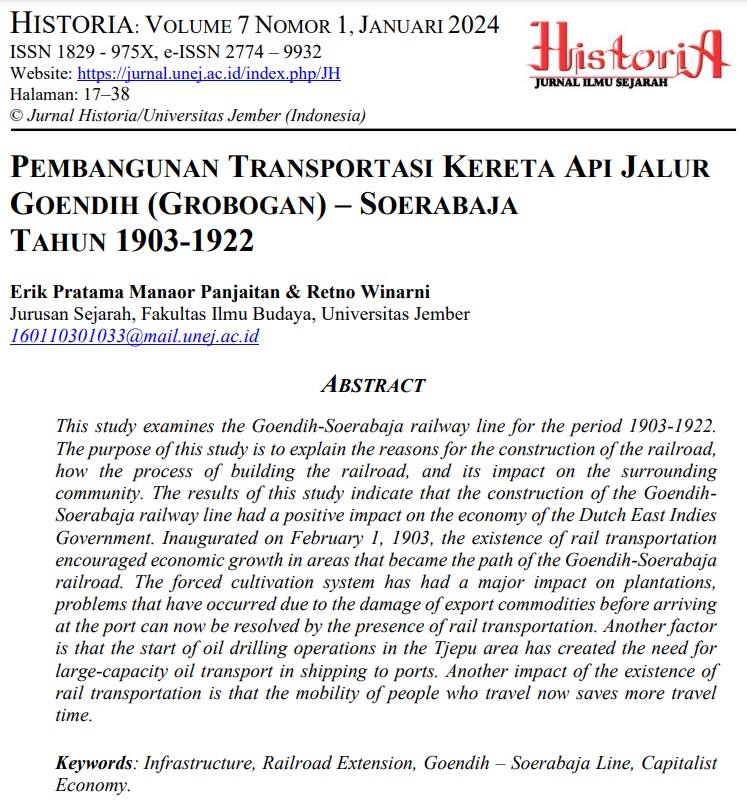PEMBANGUNAN TRANSPORTASI KERETA API JALUR GOENDIH (GROBOGAN) – SOERABAJA TAHUN 1903-1922
DOI:
https://doi.org/10.19184/jh.v7i1.41520Keywords:
Infrastructure, Railroad Extension, Goendih – Soerabaja Line, Capitalist EconomyAbstract
This study examines the Goendih-Soerabaja railway line for the period 1903-1922. The purpose of this study is to explain the reasons for the construction of the railroad, the process of building the railroad, and its impact on the surrounding community. The results of this study indicate that the construction of the Goendih-Soerabaja railway line had a positive impact on the economy of the Dutch East Indies Government. Inaugurated on February 1, 1903, rail transportation encouraged economic growth in areas that became the path of the Goendih-Soerabaja railroad. The forced cultivation system has had a major impact on plantations, problems that have occurred due to the damage of export commodities before arriving at the port can now be resolved by the presence of rail transportation. Another factor is that the start of oil drilling operations in the Tjepu area has created the need for large-capacity oil transport in shipping to ports. Another impact of the existence of rail transportation is that the mobility of people who travel now saves more travel time.
Keywords: Infrastructure; Railroad Extension; Goendih – Soerabaja Line; Capitalist Economy.
Downloads
References
Basundoro, Purnawan. “Dinamika Pengangkutan Di Banyumas Pada Era Modernisasi Transportasi Pada Awal Abad ke 20â€. Jurnal Humaniora, 20[1], 2008.
Hadinoto, Perkembangan Kota dan Arsitektur kolonial Belanda di Surabaya 1870-1940 (Yogyakarta: ANDI Yogyakarta, 1996).
Indradin & Irwan. Strategi dan Perubahan Sosial (Yogyakarta: Deepublish, 2016).
Kusumawardhani, Prita Ayu. Kereta Api di Surabaya 1910-1930 (Yogyakarta: Gapura Publishing, 2017).
Lombard, Denys. Nusa Jawa: Silang Budaya Batas-Batas Pembaratan (Jakarta: Gramedia, 2000).
Nur Cahyo, Dedi. Perkembangan Transportasi Kereta Api Di Kabupaten Lamongan Tahun 1899-1932. [Skripsi]. Universitas Negeri Surabaya, 2017.
Penders, C.L.M. Bojonegoro: 1900-1942. A Story of Endemic Poverty in North-East Java (Singapore: Gunung Agung, 1984).
Reitsma, S. A. Boekoe Peringatan dari staatsspoor-en Tramwegen di Hindia-Belanda 1875-1925 (Weltevreden: Topografischen Dienst, 1925).
Staatsblad van Nederlandsch-Indie No. 22. (1903).
Subarkah, Imam. Sekilas 125 Tahun Kereta Api Kita 1867-1992 (Bandung: Yayasan Pusat Kesejahteraan Karyawan Kereta Api, 1992).
Sunarlan, et.al. Pedoman Penyusunan Karya Ilmiah Prodi Ilmu Sejarah Fakultas Ilmu Budaya Universitas Jember (Yogyakarta: Laksbang Pressindo, 2018)
Suryo, Djoko. Sejarah Sosial Pedesaan Karesidenan Semarang 1830-1900 (Yogyakarta: Universitas Gadjah Mada, 1989).
Tim Telaga Bakti Nusantara. Sejarah perkeretaapian Indonesia [Vol. 2] (Penerbit Angkasa, 1997).
Van der Abraham, Jacob. Nederlands Oost- Indie of Beschrijving der Nederlandsche Bezittingen in Oost-Indie (Amsterdam: J. F. Schleijer, 1851).
Verslag van den Dienst van het Boschwezen Nederlandsch-Indie over heet Jaar 1904.






